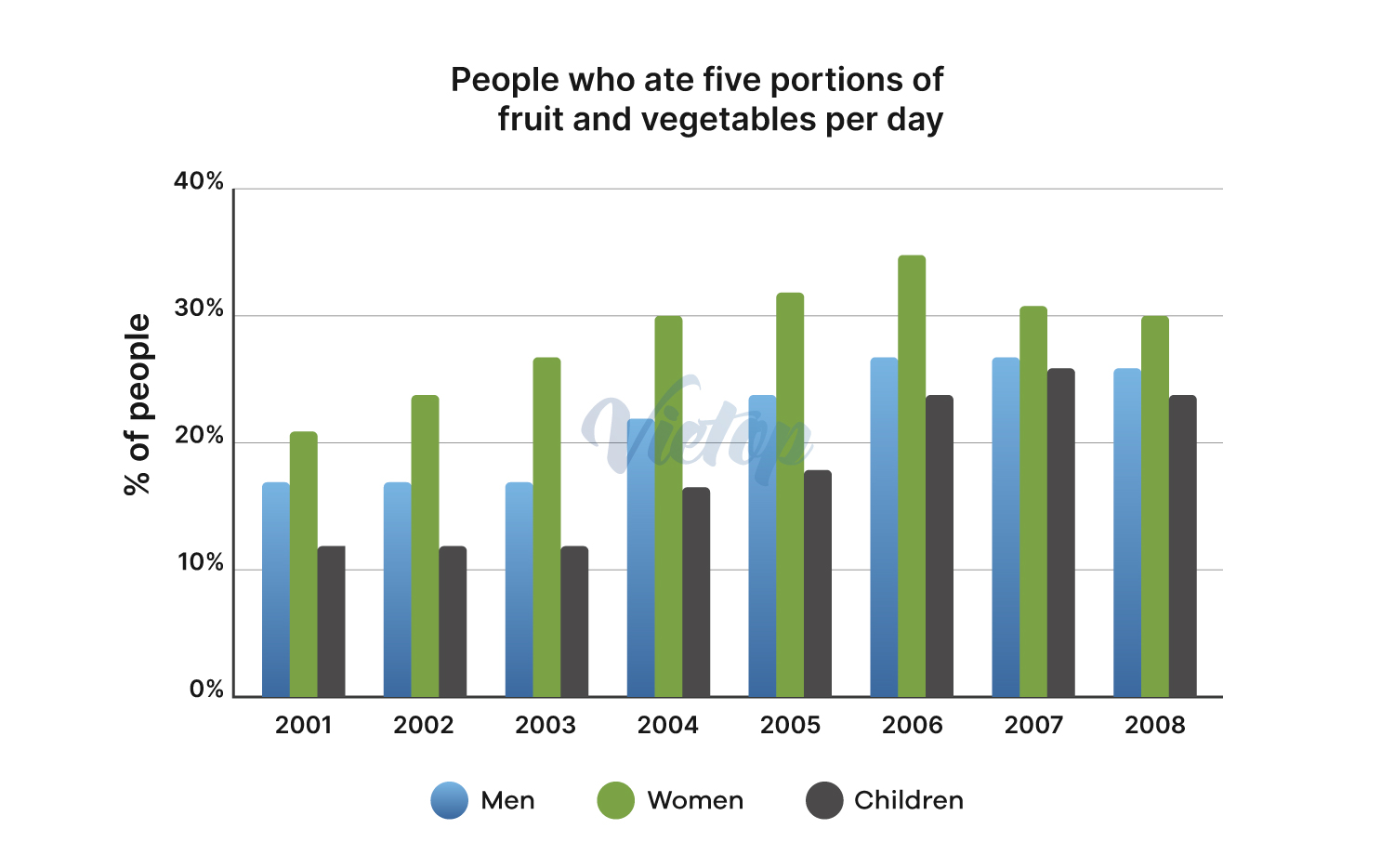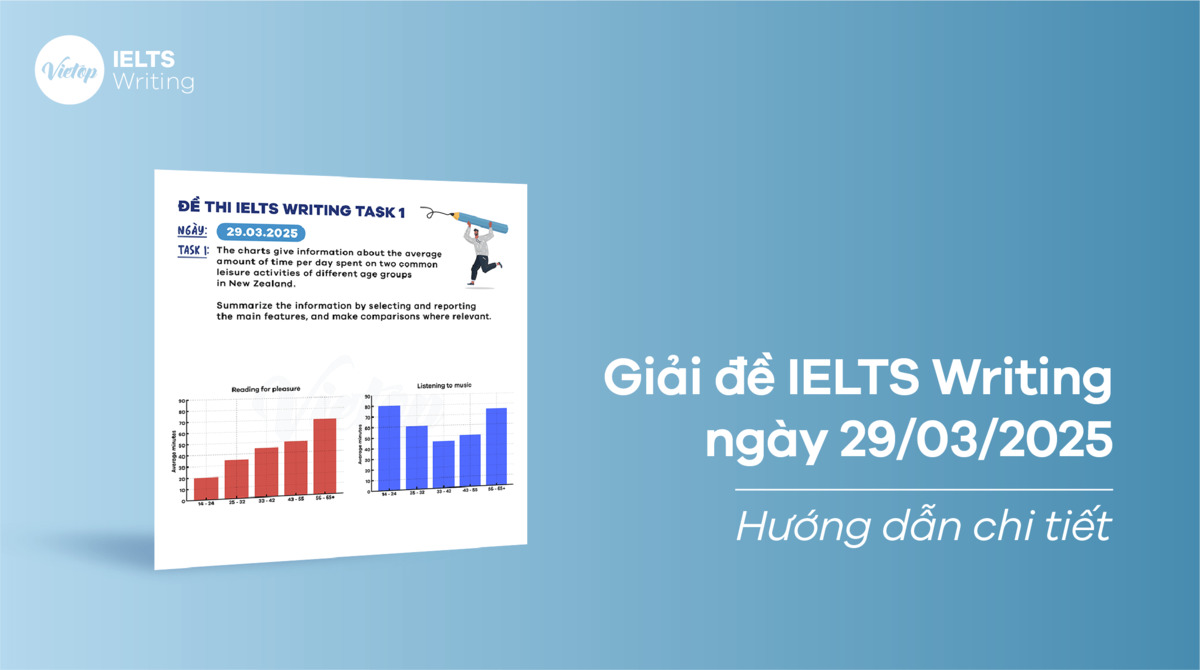Đề thi IELTS Writing ngày 02/11/2024 với sự xuất hiện của dạng bài bar chart và dạng Agree or disagree. Hãy cùng xem xét đề thi Task 1 và Task 2 để hiểu rõ hơn về cách thực hiện bài viết này:
- Đề IELTS Writing Task 1: The bar chart shows the percentage of people who ate five portions of fruits and vegetables per day in the UK from 2001 to 2008.
- Đề IELTS Writing Task 2: When asked to choose between a life without work and working most of the time, people would always choose not to work. Do you agree or disagree with this statement?
Để hiểu rõ cách viết Task 1 và Task 2 trong phần Writing của IELTS, chúng ta sẽ cùng phân tích chi tiết biểu đồ cột trong Task 1 và cách đưa ra quan điểm cá nhân trong Task 2, dựa trên các bài mẫu từ bài giải đề IELTS Writing ngày 02/11/2024.
1. IELTS Writing Task 1
| The bar chart shows the percentage of people who ate five portions of fruits and vegetables per day in the UK from 2001 to 2008. |
| (Biểu đồ cột cho thấy phần trăm người ăn 5 khẩu phần trái cây và rau củ một ngày ở Vương Quốc Anh từ năm 2001 tới năm 2008.) |

1.1. Bước 1: Phân tích đề
- Dạng biểu đồ: Bar chart
- Topic: Phần trăm số người ăn 5 khẩu phần trái cây và rau củ ở Anh từ năm 2001 tới 2007
- Place: the UK
- Number of factors: 3
- Time: from 2001 to 2007
- Tense: Các thì quá khứ
1.2. Bước 2: Lập dàn ý
Introduction: Paraphrase đề bài.
Overview:
- Overall trend: Increased consumption of fruits and vegetables
- Women consistently had the highest proportion, followed by men and children.
| Body paragraph 1: Women | Body paragraph 2: Men and Children |
| – Low proportion at the start of the surveyed period. – Steady increase until peaked in 2006.- Slow decline until the end of the period | – Similar stable trend in the first three years of the period – Significant growth in men’s consumption from 2004 to 2006. – Steady increase in children’s consumption, peaked in 2007. – At the end of the period, the consumption of fruit and vegetables for men and children had a slight decline. |
1.3. Bước 3: Bài mẫu
1.3.1. Bài mẫu band 5.0+
The bar chart illustrates the percentage of people in the UK who ate five portions of fruits and vegetables per day from 2001 to 2008.
Overall, the consumption of fruits and vegetables increased significantly among women, men, and children over this period, with women consistently having a higher intake compared to children.
At the start of the period, about 20% of women consumed the recommended portions daily. This figure climbed steadily and peaked at over 30% in 2006 before dropping slightly to around 30% by 2008.
Men and children began with just over 10% and 15%, respectively, consuming fruits and vegetables in 2001. These levels stayed relatively stable for the first three years, but then rose substantially until 2006, reaching peaks of 20% for men and 25% for children.
1.3.2. Bài mẫu band 7.0+
The provided bar chart illustrates the percentage of people in the UK who consumed five portions of fruit and vegetables per day between 2001 and 2008. The data is categorized by gender and age, specifically highlighting the consumption patterns among men, women, and children.
Overall, the chart shows an upward trend in fruit and vegetable consumption across all groups during this period, with women consistently having the highest proportion, followed by men and then children.
In 2001, women started with a relatively low percentage, around 22%. This figure gradually increased over the years, peaking in 2006 at approximately 35%. After this peak, there was a slight decline in women’s consumption, dropping to around 30% by the end of the period in 2008.
Men and children showed a similar, stable pattern in the first three years. Men’s consumption rose more noticeably from 2004, reaching its highest point in 2006 at about 28%. Children, on the other hand, showed a steady increase throughout the period, peaking at around 25% in 2007. By 2008, both men and children experienced a slight reduction in their consumption, with men at 26% and children at 20%.
Xem thêm:
- [ACE THE TEST] Giải đề IELTS Writing ngày 19/10/2024
- [ACE THE TEST] Giải đề IELTS Writing ngày 10/10/2024
- [ACE THE TEST] Giải đề IELTS Writing ngày 05/10/2024
- Tổng hợp đề thi IELTS Writing 2024 kèm bài mẫu chi tiết
1.4. Từ vựng
| Từ vựng | Nghĩa |
| Pattern /ˈpætərn/ | (noun) thói quen, khuôn mẫu E.g. She noticed a pattern in her daily routine that helped her become more productive. (Cô ấy nhận ra một thói quen trong lịch trình hàng ngày giúp cô ấy trở nên năng suất hơn.) |
| Upward trend /ˈʌpwərd trɛnd/ | (noun phrase) xu hướng tăng E.g. There has been an upward trend in online shopping over the past few years. (Đã có một xu hướng tăng trong mua sắm trực tuyến trong vài năm qua.) |
| Consumption /kənˈsʌmpʃən/ | (noun) sự tiêu thụ E.g. The high consumption of electricity during the summer months often leads to increased energy bills. (Sự tiêu thụ điện cao vào các tháng mùa hè thường dẫn đến hóa đơn năng lượng tăng.) |
| Consistently /kənˈsɪstəntli/ | (adverb) một cách nhất quán, liên tục E.g. She consistently arrives at work early, setting a great example for her team. (Cô ấy luôn đến làm việc sớm, tạo ra một tấm gương tốt cho nhóm của mình.) |
| Peaking /ˈpiːkɪŋ/ | (Present participle) đạt đỉnh, đạt mức cao nhất E.g. Sales are peaking during the holiday season due to high demand. (Doanh số đang đạt đỉnh vào mùa lễ do nhu cầu cao.) |
| Approximately /əˈprɒksɪmətli/ | (adverb) xấp xỉ, khoảng chừng E.g. The journey takes approximately two hours by car. (Hành trình mất khoảng chừng hai giờ đi bằng xe hơi.) |
| Noticeably /ˈnəʊtɪsəbli/ | (adverb) đáng chú ý, rõ rệt E.g. The weather became noticeably colder as winter approached. (Thời tiết trở nên lạnh rõ rệt khi mùa đông đến gần.) |
1.5. Cấu trúc
1.5.1. Câu phức sử dụng mệnh đề quan hệ với “who”
| S + V1 + O + who + V2 |
E.g. The provided bar chart illustrates the percentage of people in the UK who consumed five portions of fruit and vegetables per day between 2001 and 2008.
(Biểu đồ cột được cung cấp minh họa tỷ lệ phần trăm người dân ở Vương quốc Anh tiêu thụ năm phần trái cây và rau quả mỗi ngày từ năm 2001 đến năm 2008.)
1.5.2. Câu phức sử dụng hiện tại phân từ
| S + V, V-ing + O |
E.g. Men’s consumption rose more noticeably from 2004, reaching its highest point in 2006 at about 28%.
(Mức tiêu thụ của nam giới tăng rõ rệt hơn từ năm 2004, đạt mức cao nhất vào năm 2006 ở khoảng 28%.)
1.5.3. Câu bị động
| S + be + V3/ed + O |
E.g. The data is categorized by gender and age, specifically highlighting the consumption patterns among men, women, and children.
(Dữ liệu được phân loại theo giới tính và độ tuổi, đặc biệt nhấn mạnh các mô hình tiêu thụ giữa nam giới, phụ nữ và trẻ em.)
2. IELTS Writing Task 2
| When asked to choose between a life without work and working most of the time, people would always choose not to work. Do you agree or disagree with this statement? |
| (Khi được cho lựa chọn giữa một cuộc đời không làm việc và một cuộc đời làm việc xuyên suốt, người ta sẽ luôn chọn không làm việc. Bạn đồng ý hay không đồng ý với nhận định này?) |
2.1. Bước 1: Phân tích đề
- Dạng bài: Agree or disagree
- Từ khóa: asked to choose, life without work, working most of the time, people, choose not to work, agree, disagree.
- Phân tích yêu cầu: Đề bài yêu cầu bạn đưa ra ý kiến đồng ý hay không đồng ý với câu nói cho rằng người ta sẽ luôn chọn không làm việc khi được chọn giữa một cuộc đời không làm việc và cuộc đời làm việc xuyên suốt, cũng như là đưa ra các luận cứ cho quan điểm của bạn.
2.2. Bước 2: Lập dàn ý
| Introduction: Viết lại đề bài theo cách khác, sau đó đưa ra quan điểm cá nhân. | |
| Body paragraph 1: – Point: Work provides a sense of purpose and direction. + Explanation: Many people find meaning in contributing to society, achieving personal goals, or developing skills. + Evidence: Research shows prolonged unemployment can lead to low self-esteem and depression due to a lack of purpose. + Link: Work is not just about earning money; it’s central to identity and mental well-being. | Body paragraph 2: – Point: Work brings structure and routine, essential for a balanced life. + Explanation: Jobs enforce schedules that keep people productive and maintain a healthy routine. + Evidence: Studies on retirees showing decline in health due to a lack of structure after leaving work. + Link: Routine from work helps maintain discipline and satisfaction. |
| Body paragraph 3: – Point: Work fosters important social connections that support emotional health. + Explanation: The workplace is a social environment where people form relationships and collaborate. + Explanation 2: Without work, people may become isolated, which can lead to loneliness and a lower quality of life. + Link: Working helps build social networks, which enhances happiness and a sense of belonging. | |
| Conclusion: Viết lại mở bài theo cách khác, nhắc lại quan điểm cá nhân. Tóm tắt các main idea đã viết trong các đoạn thân bài. | |
Xem thêm:
- Cách viết mở bài Writing Task 2 cuốn hút
- Những mẫu câu và cụm từ “ăn điểm” trong IELTS Writing Task 2
- Cách viết Conclusion trong IELTS Writing task 2
2.3. Bước 3: Bài mẫu
2.3.1. Bài mẫu band 5.0+
Many people think that having a life without work would be very nice because they could enjoy more freedom and leisure. However, I don’t completely agree with the idea that people would always choose not to work. In my opinion, working has some important benefits, like giving people a purpose, providing a routine, and helping them make friends, which are important for a happy life.
Firstly, work gives people a meaning in life and helps them stay motivated. A lot of people feel proud of their jobs, whether they are helping others, reaching goals, or doing something they are good at. If people didn’t work, they might feel lost or bored because they don’t have anything to focus on. For example, people who are out of work for a long time often feel bad about themselves and get depressed because they have nothing to do each day. So, work is not only about making money but also about feeling good about oneself.
Secondly, having a job gives a routine to follow, which is good for people’s health. Most jobs need people to stick to a certain schedule, which helps them be more organized and productive. Without a job, people might start having unhealthy routines, like sleeping too much or doing nothing all day. Studies show that retired people who don’t have a routine usually face health problems because they lack a daily schedule. In this way, work helps people have a balanced and healthier lifestyle.
Lastly, work helps people connect with others and make friends. The workplace is a place where people can talk, work together, and feel part of a group. If people didn’t work, they might feel lonely and isolated because they miss out on daily interactions. Having a job allows people to make friends and build social circles, which makes life more enjoyable and less lonely.
In conclusion, even though a life without work sounds good, most people would still want to work because of the purpose, structure, and social life that it brings. Therefore, I don’t think people would choose to never work at all if they had a choice.
2.3.2. Bài mẫu band 7.0+
In today’s world, many people dream of a life free from work, imagining endless leisure and personal freedom. However, I disagree with the notion that people would universally prefer not to work at all. While the idea of a life without work may sound appealing, work provides important benefits such as purpose, structure, and social connection, which are essential for a fulfilling life.
First of all, work gives people a sense of purpose and direction. Many individuals find meaning in their jobs, whether through contributing to society, achieving personal goals, or simply performing tasks that require skill and dedication. A life without work could lead to a lack of motivation and aimlessness, as people might struggle to find an alternative source of purpose. For instance, research has shown that people who are unemployed for extended periods often experience feelings of low self-esteem and depression due to the absence of a clear purpose in their daily lives. Therefore, for many, work is not merely a means to earn money, but an essential component of their identity and mental well-being.
Additionally, work provides a structure to life that is difficult to replicate without a regular occupation. Most jobs require individuals to follow a schedule, which helps maintain a balanced routine and encourages productivity. Without work, people may fall into irregular habits that could be detrimental to their health and overall well-being. Studies have shown that retirees who do not engage in regular activities often experience a decline in both physical and mental health, largely due to the loss of routine that work provides. Thus, the structured environment of a job is beneficial for maintaining discipline and overall life satisfaction.
Finally, work fosters social connections, which are vital for emotional health. The workplace is a key environment for forming relationships, collaborating on tasks, and feeling part of a community. Without work, people might become isolated, as they would lose a significant source of daily social interaction. This isolation could lead to loneliness and reduced quality of life. In contrast, people who work are more likely to develop friendships and build social networks that extend beyond the workplace, enhancing their sense of belonging and happiness.
In conclusion, while a life without work may initially seem attractive, most people would find long-term fulfillment in work because of the sense of purpose, structure, and social engagement it provides. Therefore, I disagree with the statement and believe that people would generally choose to work, even if given the choice not to.
2.4. Từ vựng
| Từ vựng | Nghĩa |
| Leisure /ˈliːʒər/ | (noun) thời gian rảnh rỗi, giải trí E.g. In her leisure time, she enjoys reading books and hiking. (Trong thời gian rảnh rỗi, cô ấy thích đọc sách và đi bộ đường dài.) |
| Notion /ˈnoʊʃən/ | (noun) khái niệm, ý niệm E.g. He had a vague notion of what the project would involve but needed more details. (Anh ấy có một khái niệm mơ hồ về những gì dự án sẽ bao gồm, nhưng cần thêm chi tiết.) |
| Universally /ˌjuːnɪˈvɜːrsəli/ | (adverb) một cách phổ biến, toàn cầu E.g. The new policy was universally accepted by all employees. (Chính sách mới đã được tất cả nhân viên chấp nhận một cách phổ biến.) |
| Appealing /əˈpiːlɪŋ/ | (adjective) hấp dẫn, thu hút E.g. The idea of a beach vacation is very appealing to her. (Ý tưởng về một kỳ nghỉ trên bãi biển rất hấp dẫn đối với cô ấy.) |
| Fulfilling life /fʊlˈfɪlɪŋ laɪf/ | (noun phrase) cuộc sống trọn vẹn, cuộc sống ý nghĩa E.g. She believes that helping others is the key to a fulfilling life. (Cô ấy tin rằng giúp đỡ người khác là chìa khóa cho một cuộc sống trọn vẹn.) |
| Aimlessness /ˈeɪmləsnəs/ | (noun) sự không mục đích, sự vô định E.g. After graduation, he felt a sense of aimlessness, unsure of what to do next. (Sau khi tốt nghiệp, anh ấy cảm thấy một sự vô định, không chắc nên làm gì tiếp theo.) |
| Alternative /ɔːlˈtɜːrnətɪv/ | (noun/adjective) Sự thay thế/ thay thế, thay phiên E.g. We need to find an alternative if this plan doesn’t work. (Chúng ta cần tìm một sự thay thế nếu kế hoạch này không hiệu quả.) |
| Unemployed /ˌʌnɪmˈplɔɪd/ | (adjective) thất nghiệp E.g. After the company closed, many workers were left unemployed. (Sau khi công ty đóng cửa, nhiều công nhân đã bị thất nghiệp.) |
| Extended periods /ɪkˈstɛndɪd ˈpɪəriədz/ | (noun phrase) khoảng thời gian kéo dài, thời gian dài E.g. Sitting for extended periods can lead to health problems. (Ngồi trong thời gian dài có thể dẫn đến các vấn đề sức khỏe.) |
| Self-esteem /sɛlf-əˈstim/ | (noun) lòng tự trọng E.g. Positive feedback from her peers helped boost her self-esteem. (Những phản hồi tích cực từ bạn bè đã giúp tăng lòng tự trọng của cô ấy.) |
| Replicate /ˈrɛpləˌkeɪt/ | (verb) tái tạo, sao chép, nhân bản E.g. Scientists were able to replicate the experiment with similar results. (Các nhà khoa học đã có thể tái tạo thí nghiệm với kết quả tương tự.) |
| Irregular /ɪˈrɛɡjələr/ | (adjective) không đều, bất thường E.g. His irregular work hours made it difficult to establish a routine. (Giờ làm việc bất thường của anh ấy khiến việc thiết lập một thói quen trở nên khó khăn.) |
| Detrimental /ˌdɛtrɪˈmɛntl/ | (adjective) có hại, bất lợi E.g. Smoking has a detrimental effect on health. (Hút thuốc có ảnh hưởng có hại đến sức khỏe.) |
| Retiree /rɪˌtaɪˈriː/ | (noun) người đã nghỉ hưu E.g. The community center offers special activities for retirees. (Trung tâm cộng đồng cung cấp các hoạt động đặc biệt cho những người đã nghỉ hưu.) |
| Vital /ˈvaɪtl/ | (adjective) quan trọng, thiết yếu E.g. Proper hydration is vital for maintaining good health. (Cung cấp đủ nước là thiết yếu để duy trì sức khỏe tốt.) |
| Collaborate /kəˈlæbəˌreɪt/ | (verb) hợp tác, cộng tác E.g. The two companies decided to collaborate on a new project. (Hai công ty đã quyết định hợp tác trong một dự án mới.) |
| Sense of belonging /sɛns əv bɪˈlɒŋɪŋ/ | (noun phrase) cảm giác thuộc về, cảm giác gắn bó E.g. Joining the community group gave her a strong sense of belonging. (Tham gia vào nhóm cộng đồng mang lại cho cô ta cảm giác gắn bó mạnh mẽ.) |
Xem thêm:
- Cách viết dạng Positive & Negative – IELTS Writing Task 2
- Cách viết Discussion Essay trong IELTS Writing Task 2
- Cách viết Discuss Both View And Give Your Opinion trong IELTS Writing Task 2
2.5. Cấu trúc
2.5.1. Câu phức sử dụng While ở đầu câu
| While + [mệnh đề phụ], [mệnh đề chính]. |
E.g. While the idea of a life without work may sound appealing, work provides important benefits such as purpose, structure, and social connection.
(Mặc dù ý tưởng về một cuộc sống không có công việc nghe có vẻ hấp dẫn, công việc mang lại những lợi ích quan trọng như mục đích, cấu trúc và kết nối xã hội.)
2.5.2. Cấu trúc song song với danh động từ
E.g. Many individuals find meaning in their jobs, whether through contributing to society, achieving personal goals, or simply performing tasks that require skill and dedication.
(Nhiều cá nhân tìm thấy ý nghĩa trong công việc của họ, dù là thông qua việc đóng góp cho xã hội, đạt được các mục tiêu cá nhân, hay đơn giản là thực hiện các nhiệm vụ đòi hỏi kỹ năng và sự tận tâm.)
Trong câu này, mình sử dụng cấu trúc song song với các cụm danh động từ (contributing to society, achieving personal goals, performing tasks) để liệt kê ra những ý nghĩa có thể được tìm thấy trong công việc, và để làm cho câu văn rõ ràng, có nhịp điệu, dễ đọc.
2.5.3. Câu điều kiện với mệnh đề if rút gọn
| If + S + V2/ed, S + would + V-inf |
E.g. People would generally choose to work, even if given the choice not to.
(Người ta sẽ thường chọn làm việc, cho dù có được cho lựa chọn không làm.)
Trong câu này, mệnh đề “even if given the choice not to” đã được rút gọn từ câu “even if they were given the choice not to”. Mình rút gọn như vậy để làm cho câu văn gọn hơn, dễ đọc hơn.
3. Kết bài
Hy vọng bài giải đề IELTS Writing ngày 02/11/2024 đã chia sẻ đến bạn những kiến thức hữu ích khi nắm vững cách phân tích đề bài, lập dàn ý và viết bài mẫu. Nếu bạn có bất kỳ thắc mắc nào, hãy để lại bình luận bên dưới bài viết, đội ngũ biên tập viên sẽ giải đáp cho bạn.
Bên cạnh đó, để đạt được kết quả như mong muốn trong phần thi IELTS Writing, việc luyện tập đều đặn và nhận phản hồi từ giáo viên là rất quan trọng. Nếu bạn cần sự hỗ trợ tận tâm từ đội ngũ giảng viên, các khóa học tại IELTS Vietop sẽ là lựa chọn lý tưởng giúp bạn đạt được mục tiêu IELTS của mình.
Chúc các bạn ôn tập tốt và đạt kết quả cao trong kỳ thi IELTS sắp tới!


![[ACE THE TEST] Giải đề IELTS Writing ngày 07/04/2025](https://vietop.edu.vn/wp-content/uploads/2025/04/giai-de-ielts-writing-ngay-07-04-2025.png)

![[ACE THE TEST] Giải đề IELTS Writing ngày 15/03/2025](https://vietop.edu.vn/wp-content/uploads/2025/03/giai-de-ielts-writing-ngay-15-03-2025.jpg)
![[ACE THE TEST] Giải đề IELTS Writing ngày 22/03/2025](https://vietop.edu.vn/wp-content/uploads/2025/03/giai-de-ielts-writing-ngay-22-03-2025.jpg)
![[ACE THE TEST] Giải đề IELTS Writing ngày 08/03/2025](https://vietop.edu.vn/wp-content/uploads/2025/03/giai-de-ielts-writing-ngay-08-03-2025.jpg)
![[ACE THE TEST] Giải đề IELTS Writing ngày 06/03/2025](https://vietop.edu.vn/wp-content/uploads/2025/03/giai-de-ielts-writing-ngay-06-03-2025.jpg)
![[ACE THE TEST] Giải đề IELTS Writing ngày 22/02/2025](https://vietop.edu.vn/wp-content/uploads/2025/02/giai-de-ielts-writing-ngay-22-02-2025.jpg)
